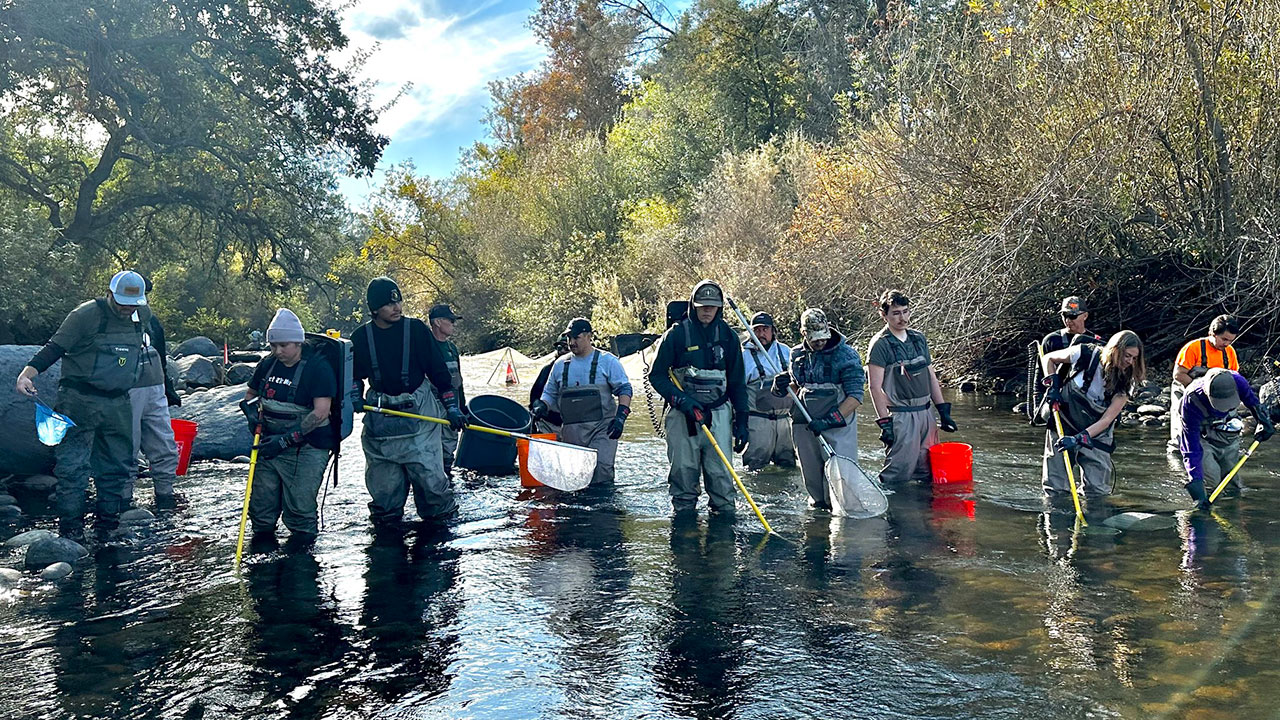Share
![]()
■Leah Richardson, a student at Santa Rosa Junior College, is one of the first recipients of the Hire UP program.
■The program pays students for every hour they spend in class and on homework.
■The Hire UP program is seen as a “glimmer of hope” for students struggling with financial difficulties.
Leah Richardson is juggling community college and work, but her job doesn’t pay enough to cover the cost of living in Sonoma County. Often, she relies on a food pantry, despite receiving thousands of dollars in financial aid from her school, Santa Rosa Junior College.

Adam Echelman
CalMatters
Now a new program will pay her for every hour she spends in class and on homework. The $30 million state program, called Hire UP, is an experiment modeled on the state’s many guaranteed income programs. It focuses on students who are formerly incarcerated, like Richardson, as well as former or current foster youth, and those receiving CalWorks benefits, the state’s cash aid program for low-income adults with children. Ten community college districts received the money and some schools, including Santa Rosa Junior College, are beginning to distribute it now. Others have yet to set a timeline.
Richardson, 37, is one of the first recipients. On a recent morning, she sat at a cafe next to campus, where students hurried by, but she didn’t notice them as she stared at her financial aid statement on her iPhone.
“I’m a little in shock,” she said as she used her fingers to zoom in on the web page that showed her current grants.
She’ll receive monthly payments of nearly $2,000, starting today. Those payments are calculated based on the state’s minimum wage, $16 an hour, for each of the 30 hours she spends every week on school.

When she enrolled at Santa Rosa Junior College in 2021, she couldn’t afford to attend full time. She was still adjusting to a new routine, after spending time in and out of jail and substance use treatment centers. She decided to take classes in the afternoon and work from 4:30 a.m. until about 1:30 p.m. at a Safeway store most days of the week. When she wasn’t working at Safeway, she took shifts at bakeries.
“I was exhausted — a lot,” she said. Since then, she’s tried to work less and study more. “Now that I have this money, I don’t have the weight of having to go back to a job that’s going to drain me.”
Gina Browne, an assistant vice chancellor with the California Community Colleges Chancellor’s Office, said the office is monitoring how well colleges administer the program and how the money affects students’ outcomes.
“Some students who are working now may be able to stop working or reduce their hours,” she said. “We want students to focus on taking those units so they can get through (college).”
Student Aid Offers ‘A Glimmer of Hope’
Every Tuesday, formerly incarcerated students at Santa Rosa Junior College gather in a multi-purpose conference room on campus, part of a state-funded support program known locally as Second Chance. Men with scraggly beards or neck tattoos wave to younger men and women as they walk in. Some students wear T-shirts while others are in button-downs or blouses. It’s a cross-section of the college and the city at large. Modeled like a 12-step recovery meeting, students speak up, one by one, sharing their stories about navigating work, school and life after prison.

Matthew Domingos, 42, helps moderate. He works part time for the college as he finishes an associate degree and prepares to transfer next semester to Cal Poly Humboldt. As a full-time student, his financial aid package totals around $10,000 a semester but it doesn’t leave any wiggle room, he said. “I feel like I’m one trip to the emergency room away from homelessness.” He was selected for Hire UP, but he doesn’t yet know how much money he’ll receive.
Richardson can’t always attend the weekly meetings because of her work and school schedule, though she wishes she could. She pays about $1,100 a month toward rent and hundreds more on utilities, food, and transportation. “I don’t spend money,” she said. “There isn’t any to spend.”
There are roughly 160 formerly incarcerated students who enroll each year at Santa Rosa Junior College, all of whom may apply for Hire UP, said Jessy Paisley, a counselor for the Second Chance program on campus.
That money is a “glimmer of hope,” she said. “How do you focus on turning in your Canvas assignment if you don’t even know where you’re going to charge your computer tonight, or sleep, or get your next meal?”

What Happens When the Money Runs Out
The average cost of attending Santa Rosa Junior College, including living expenses, is about $20,000 to $30,000 a year, depending on whether students pay rent, said Rachael Cutcher, the college’s director of financial aid. For in-state students, tuition is less than 7% of their total annual expenses. The rest is rent, transportation, food and books.
Many students at the community college qualify for financial aid. However, the amount of aid typically depends on the number of classes that students take, and at Santa Rosa Junior College, most students are part time. Cutcher said the average financial aid package is around $10,000 a year.
The Sonoma County Junior College District, which oversees Santa Rosa Junior College, received just over $2.6 million for Hire UP, but the money can’t help all the students who qualify. The college has roughly 600 students who are formerly incarcerated, current or former foster youth, or CalWorks recipients, according to data from the chancellor’s office. If all of those students were to get a portion, the money would run out in a few months.
“We’re prioritizing our formerly incarcerated students as our first tier,” Cutcher said, later adding that the other populations are already eligible for their own special scholarships or government grants. “Then if we have enough funding, we’ll go to foster youth, then CalWorks. If it’s successful, I’d advocate for it to be renewed and offered more broadly.”
Other schools, such as those in the San Diego Community College District, expect to exhaust most of the money in the first two years, said Susan Topham, the vice chancellor of educational services for the district.
“We want them to run out of money,” said Browne. If community college districts spend it all and the benefits of the money are apparent, she said the chancellor’s office can advocate for more funding, either for this program or for similar ones.
California’s Financial Aid Is Stuck in 1969
Compared to other state and federal financial aid programs, the money from Hire UP is relatively small.
In the 2022-23 academic year, California gave community college students more than $700 million in state aid, according to data from the chancellor’s office. The same year, the federal government gave out nearly $1.7 billion in grants to community college students, including Pell grants for low-income students as well as one-time money from various COVID-19 spending bills.
But on a per-person basis, the money doesn’t always go far. For example, community college students typically receive just over $1,600 a year for non-tuition costs from the state’s cornerstone financial aid program, the Cal Grant.
That grant amount was first set in 1969, said Manny Rodriguez, the California director of policy and advocacy at The Institute for College Access and Success. “If it kept up with inflation, it should be worth between $7,000 and $8,000 today.”
“How do you focus on turning in your Canvas assignment if you don’t even know where you’re going to charge your computer tonight, or sleep, or get your next meal?”
–Jessy Paisley, a counselor at Santa Rosa Junior College
For years, advocates like Rodriguez have worked with the chancellor’s office to push the state to give students more cash. In 2022, California legislators passed a new law that would slowly increase the amount of state money provided through the Cal Grant program.
However, the increases to Cal Grant will only go into effect if Gov. Gavin Newsom and the Legislature agree to put the money into this year’s budget. Newsom has until May to release a revised state budget proposal, which includes the financial aid program. But with a multi-billion dollar projected deficit looming, advocates are worried that reforms may have to wait.
The federal and state financial aid programs also come with requirements many students fail to meet. The state’s largest financial aid program for community college students, the Student Success Completion Grant, requires students to take a full course load, typically at least four classes each semester.
Hire UP is structured differently. Part-time students can qualify, as long as they take at least two classes. The money is disbursed and recalculated every month, depending on how many classes the student took.

Domingos is a full-time student, so he qualifies for the Completion Grant. It’s one reason why he receives more financial aid than the average student. However, Richardson has never been able to receive the Completion Grant because her work schedule prevents her from taking more than three classes. While Domingos receives federal aid, Richardson’s income is too high to qualify.
Richardson will receive over $8,000 in Hire UP payments during the spring semester. That will be in addition to the $4,000 in financial aid she was already getting for the same time period.
Santa Rosa Junior College may run out of money for Hire UP, but Cutcher said the financial aid department has budgeted the program so that students who receive initial payments are guaranteed money until they graduate. That means Richardson could receive more than $20,000 from Hire UP before she graduates next year.
“No matter what,” she said. “I’m going to be ecstatic with whatever the state can offer me.”
About the Author
Adam Echelman covers community colleges through a partnership with Open Campus. He joined CalMatters from the Modesto Bee, where he covered issues of equity across Stanislaus County. Previously, he served as the Executive Director of Libraries Without Borders, a national nonprofit organization committed to promoting access to information. He’s a graduate of Yale University.
About CalMatters
CalMatters is a nonprofit, nonpartisan newsroom committed to explaining California policy and politics.
RELATED TOPICS:
Categories

SNAP Recipients Plan Thanksgiving, Down to Their Last Cent


















